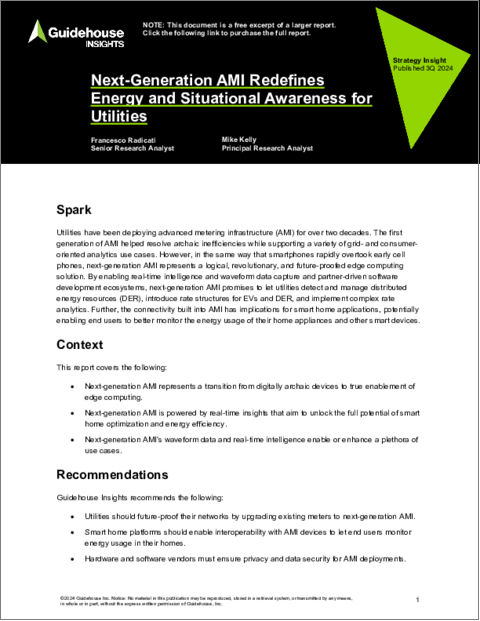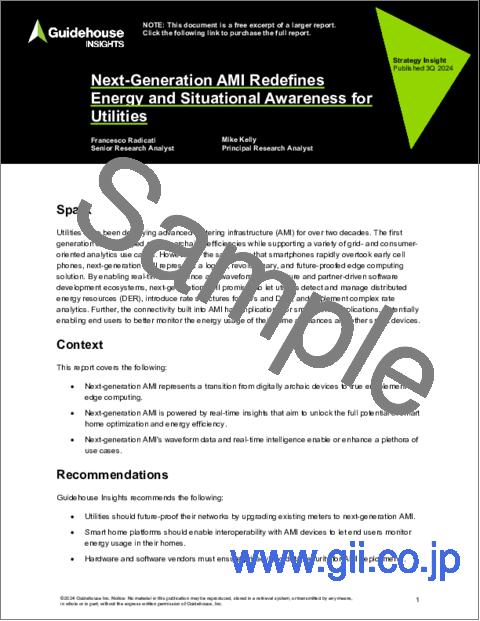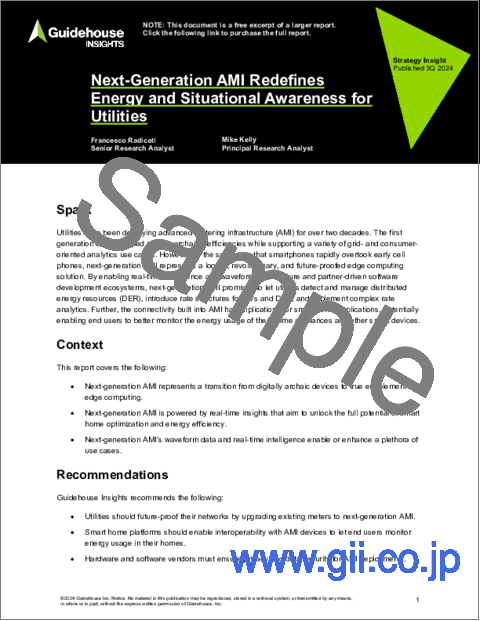|
|
市場調査レポート
商品コード
1556459
次世代AMIによるエネルギーの再定義と公益事業者向けの状況認識Next-Generation AMI Redefines Energy and Situational Awareness for Utilities |
||||||
|
|||||||
| 次世代AMIによるエネルギーの再定義と公益事業者向けの状況認識 |
|
出版日: 2024年09月17日
発行: Guidehouse Research
ページ情報: 英文 12 Pages
納期: 即納可能
|
全表示
- 概要
- 目次
公益事業者は、20年以上にわたって高度計測インフラ (AMI) を導入してきました。第一世代のAMIは、電力網や消費者向けのさまざまな使用事例を活用しながら、古めかしい非効率性を解決するのに役立ちました。しかし、スマートフォンが初期の携帯電話を急速に追い越したのと同じように、次世代AMIは論理的かつ革命的で、将来性のあるエッジコンピューティング・ソリューションです。次世代AMIは、リアルタイム情報と波形データの取得を可能にし、パートナー主導のソフトウェア開発エコシステムを実現することで、公益事業者が分散型エネルギー資源 (DER) を検出・管理し、EVやDER向けの料金体系を導入し、複雑な料金分析を実施できるようにします。さらに、AMIに組み込まれたコネクティビティは、スマートホームの活用領域に影響を与え、エンドユーザーが家電などのスマートデバイスのエネルギー使用量をよりよく監視できるようになる可能性があります。
第一世代AMIの導入が寿命を迎えるにつれ、公益事業者はネットワークの将来性を確保し、自社と顧客のエネルギー使用に関する洞察を引き出すため、次世代AMIを選択する傾向が強まっています。当レポートでは、エネルギー効率やサイバーセキュリティ・スマートホームの観点から次世代AMIの利点を論じ、公益事業者のみならず、ハードウェア・ソフトウェアベンダーにも推奨事項を示しています。
目次
- 序論
- 背景事情
- 提言
- 次世代AMI:デジタル的に時代遅れのデバイスから、エッジコンピューティングの真の実現への移行を表現
- DER・エネルギー効率・顧客満足度:AMI 2.0の重要な促進要因
- DER (分散型エネルギー資源) とEV管理
- エネルギー効率、信頼性、値ごろ感
- 顧客満足度
- スマートメーターが、エッジコンピューティングのプラットフォームとなる
- ユーティリティ分析戦略:記述的・予測的なものから、規範的なものへと移行する必要性
- 北米が展開件数の大半を占めるが、他の地域も追いつく見通し
- リアルタイムの洞察力を備えた次世代AMI:スマートホーム最適化・エネルギー効率の可能性を最大限に引き出すことを企図する
- IEEE 2030.5がスマートホーム通信のエコシステムに加わる
- AMIに接続するブロードバンドネットワークの役割
- AMI:家庭用電力監視デバイスよりも、消費者にとってアクセスが容易
- スマートホームでは、AMIと家庭用電力監視デバイスとが共存可能
- 次世代AMIが、料金体系の進歩を可能にする
- 次世代AMIの波形データとリアルタイムインテリジェンスにより、さまざまな利用事例が実現・強化される
- 公益事業者は既存のメーターを次世代AMIに更新し、未来に向けたネットワークを構築すべし
- スマートホームプラットフォームは、AMIデバイスとの相互運用性を実現し、エンドユーザーが自宅のエネルギー使用量を監視できるようにする必要がある
- ハードウェア/ソフトウェアベンダーは、AMI展開におけるプライバシーとデータセキュリティを確保する必要がある
Utilities have been deploying advanced metering infrastructure (AMI) for over two decades. The first generation of AMI helped resolve archaic inefficiencies while supporting a variety of grid- and consumer-oriented analytics use cases. However, in the same way that smartphones rapidly overtook early cell phones, next-generation AMI represents a logical, revolutionary, and future-proofed edge computing solution. By enabling real-time intelligence and waveform data capture and partner-driven software development ecosystems, next-generation AMI promises to let utilities detect and manage distributed energy resources (DER), introduce rate structures for EVs and DER, and implement complex rate analytics. Further, the connectivity built into AMI has implications for smart home applications, potentially enabling end users to better monitor the energy usage of their home appliances and other smart devices.
As first-generation AMI deployments reach the end of their lifespans, utilities are increasingly opting for next-generation AMI to future-proof their networks and unlock insights into energy use for themselves and their customers. This Guidehouse Insights report discusses the benefits of next-generation AMI in the context of energy efficiency, cybersecurity, and the smart home, and provides recommendations for utilities as well as hardware and software vendors.
Table of Contents
Spark
Context
Recommendations
Next-Generation AMI Represents a Transition from Digitally Archaic Devices to True Enablement of Edge Computing
DER, Energy Efficiency, and Customer Satisfaction Are Key AMI 2.0 Drivers
DER and EV Management
Energy Efficiency, Reliability, and Affordability
Customer Satisfaction
Smart Meters Have Become Edge Computing Platforms
Utility Analytics Strategies Should Move from Descriptive and Predictive to Prescriptive
North America Dominates Deployments, but Other Regions Will Catch Up
Next-Generation AMI Is Powered by Real-Time Insights That Aim to Unlock the Full Potential of Smart Home Optimization and Energy Efficiency
IEEE 2030.5 Will Join the Smart Home Communications Ecosystem
The Role of Broadband Networks in Connecting AMI
AMI Is More Accessible to Consumers Than In-Home Power-Monitoring Devices
AMI and In-Home Power-Monitoring Devices Can Coexist in the Smart Home
Next-Generation AMI Will Enable Advances in Rate Structures
Next-Generation AMI's Waveform Data and Real-Time Intelligence Enable or Enhance a Plethora of Use Cases
Utilities Should Future-Proof Their Networks by Upgrading Existing Meters to Next-Generation AMI
Smart Home Platforms Should Enable Interoperability with AMI Devices to Let End Users Monitor Energy Usage in Their Homes
Hardware and Software Vendors Must Ensure Privacy and Data Security for AMI Deployments





